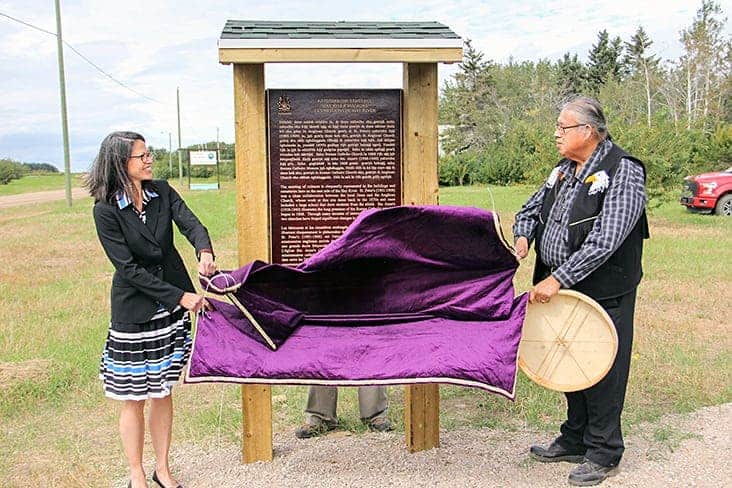A new plaque describing the historical significance of the Hay River Missions site on the Hay River Reserve was unveiled on Aug. 15.
The plaque from the Historic Sites and Monuments Board of Canada, and Parks Canada, tells why the area in the Old Village is considered a National Historic Site, a status first recognized in 2002.

It is the location of cemeteries and churches – St. Anne's Roman Catholic Church still standing and St. Peter's Anglican Church severely damaged by ice in the spring flooding of 2008 – and where a hospital and residential school once stood.
The presence of the Roman Catholic mission dates back to 1868, while the Anglican Church mission was established in the 1870s.
However, as Chief Roy Fabian told The Hub it is even more than an historic site to K'atlodeeche First Nation.
"To us, it's a sacred site," said Fabian. "There were quite a few things happened there and it was a painful part of our history. The graveyard has some children buried there. To us, it's a sacred place. So we want to keep it that way. We want to just keep it as a sacred area and try to respect the people."
The chief noted that the First Nation previously erected its own monument – a gazebo-like structure topped by a bell from the residential school that people can ring in remembrance. The structure also features the official apologies for the residential school system from the Government of Canada and the Anglican Church.
"We don't forget the young people that died there and the people that suffered there," Fabian said.
St. Peter's Indian Residential School was operated by the Anglican Church from 1893 to 1937, and children were brought there from many other communities.
"An interesting thing was my grandmother was one of the first residential school people to grow up in this school," Fabian told people at the unveiling ceremony.
On Aug. 15, the new plaque was unveiled by Fabian and Lisa Prosper, the NWT representative on the Historic Sites and Monuments Board of Canada.
"Today we officially welcome Hay River Missions to our country's family of commemorated places, persons and events of national historic significance," Prosper said.
She said the federal government is committed to reconciliation and renewing the relationship with Indigenous peoples, and in particular the Historic Sites and Monuments Board of Canada has taken steps to increase the number of Indigenous designations made each year.
"Since 2017, nine Indigenous commemoration events have taken place, including the commemoration of aboriginal military service in the First World War," she noted. "These designations and plaque unveilings bring people together to foster greater understanding between Indigenous peoples in Canada and non-Indigenous Canadians. We hope these events help open discussions of the histories, cultures and realities of Indigenous communities."
One recommendation of the Truth and Reconciliation Commission of Canada was for historical commemoration activities and acknowledgement of the contributions that Indigenous peoples have made to Canada's history.
"The Hay River Missions constitute an important part of the K'atlodeeche First Nation's history and our country's history," said Prosper. "The commemoration of historic designations like the Hay River Missions reflects the rich and varied history of our country and provides opportunities for us to learn more about our heritage."